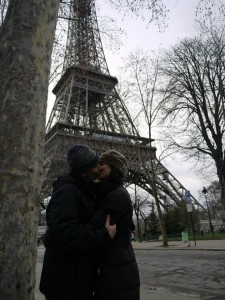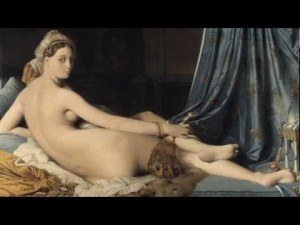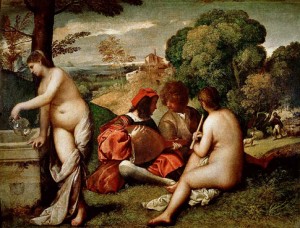There was no way we would not try to embarrass our children, and so we did!
Recently, I traveled to Paris and discovered what all the fuss is about–why people fall in love with this place, and why it’s depicted as the city of romance. It hit me the moment I arrived, and as soon as I left the Gare-du-Nord train station where cobblestone streets and magnificent architecture with whitewashed shutters adorned every inch of the city. That was my first impression before my full ingress into a new, exciting culture. Thankfully, there was so much traffic that our taxi could only proceed at a snail’s pace, giving us ample opportunity to absorb everything outside. The cafes and bakeries along the way were enough to send my head spinning, never had I seen such a vast array of eateries anywhere else that I’ve visited, or seen so many stores all nestled in such scenic surroundings. As soon as we arrived at our hotel, near the Eiffel Tower, I couldn’t wait to go out to a local patisserie and bite into a crispy baguette and experience a Parisian pastry. My husband’s pleas to sit in a proper restaurant where he would have space to rest his tired feet went unnoticed by me; all I cared about was satisfying my craving for French baked goods. The moment I noticed the display of food through the window of the first patisserie that we passed, I sighed. No one spoke English, but the language of bread and cake is universal, so no problem there. From that point on Paris, for me, became a city filled with temptation because everywhere I turned and saw signs for patisseries I knew what flavorful pleasures awaited me. We didn’t only eat bread and cake, but also dined in proper French restaurants to get a gauge for other local delicacies. We made sure to walk for miles after each meal in order to develop an appetite before our next eating adventure. Sounds like gluttonous behavior, and that is exactly the way it was. Missing, thank goodness, from the scenery were the big yellow McDonald’s arches that can be seen in almost every metropolitan city worldwide, and the one and only American chain food fare near our hotel had a very tiny arch, almost unrecognizable as though ashamed and wanting to hide. I had to peek just to see whether the menu was the same; I remembered that a McDonald’s in Israel served McKabob, and in England they had an “After Eight” McFlurry. I wondered what variation of the usual menu this French McDonald’s would offer, and I giggled when looking at the McCafe’s dessert section with its colorful macaroons and other delectable cakes—it was nothing like the options offered in the US. While in France, I made sure to eat in non-chain restaurants and cafés, not difficult to find in a country renowned for its gastronomic prestige. It drizzled most of the time, yet people sat outside, unaffected and undeterred by weather, and looking complacent as they ate, drank and smoked. A plume of smoke hovered above most tables, something of a contrast in a city that was purposely razed, renovated and transformed over a century ago in order to get rid of despair and squalor. But for Parisians smoking is associated with joyous debauchery, eating and conversing and we were the minority with our self-betterment ideas and a smoke-free environment. We dropped the issue right away, its wasn’t worth spending one more minute comparing or discussing in the short time we had to enjoy ourselves. Every corner I turned surprised me with more restaurants, more shops, and more beautiful apartment buildings. Perhaps it was the feeling that I would never have enough time to do it all, and see everything which added an element of awe and excitement.
But enough about the food, because if you strip that away, there is still so much more to do such as our walks along the Seine, morning or night; delighting in th the way the Eiffel tower glistened when it lit up in the dark; the way the Champs Elysees looked when standing at the very end of the street, looking onward toward the Arc de Triomphe—a monument that stood big and tall amidst the modern-looking shops along this glorious street. A reminder that when those stores close or change hands, the Arc de Triomphe will still be there standing aloof, looking down on all of us, pretentious and judgmental. It has earned the right to do so. I couldn’t wait to visit the Muse du Louvre, holding some of the world’s most valuable art. On that particular day the sky was especially grim, which added another layer of romance and mystique as we walked along the Siene towards our destination. The gravel path leading to the museum produced a crunching sound as if to let us know that we were about to see something grand. Ignoring the onslaught of tourists all around, we stood in the courtyard admiring a structure that had stood there since 1190, at first built as a fortress to protect the city but over the centuries it had gone through so many transformations and in modern times one of the biggest tourist attractions in the world. The scenery was surreal, old and new sitting side by side welcoming our minds to wander through time. Thanks to clever thinking and purchasing our tickets ahead of time, we skipped the insufferable long line outside, and headed straight towards the Italian section in order to see the one and only Mona Lisa. We figured that with a five-year-old in tow it was the best strategy before he would realize here were no dinosaur bones to see, and an imminent meltdown would ensue.
Reaching the Mona Lisa was not an easy feat. The building was huge and there was so much to see, but most everyone congregated around Leonardo da Vinci’s famous painting, especially at that specific time because of a new theory–something to do with a hidden code da Vinci included in his work. Honestly, I had no interest in looking for those iconographic symbols; I just wanted a candidate view of a portrait I had only seen in books. After standing in line for thirty minutes, hoping that people would eventually let us through, we finally decided to do the European thing and force our way in. With elbows bent to the sides of our body, we shoved and pushed like the best of them, and only then were we able to plow our way through an aggressive crowd and slowly advance towards the object of our interest, the Mona Lisa. Once we reached the outer rope, the one preventing anyone from getting any closer to the painting, it was a struggle to remain there for more than a minute as the perpetual shoving continued, and like an underwater current that would sweep you away from shore, we found ourselves moving away from the painting as well. I would’ve preferred to see the painting in a more relaxed atmosphere, instead of having to muscle my way in and endure people’s bad hygiene as they rubbed against me, but at the end of the day it was worth all the hard work and insufferable behavior.
I had seen Leonardo’s work before, years ago, but I never saw the Mona Lisa; although familiar with the painting, there was something extraordinary about viewing a classic up front. We didn’t spend as much time as we wanted in the museum, because at that stage Jack was bored stiff, albeit he managed to point at a few bare breasts and giggle, but the was and positively confident that we were not in the right museum. So we did our best to soak up as much as we could until we reached the elevators at the end of the wing. I had forgotten how large some of those paintings were, and I’m talking about framed paintings and not frescoes. The Infant Jesus and the Virgin Mary appeared in supernatural apparitions, and were the theme in most of the paintings we saw, but what caught my attention mostly was the artists’ depiction of the female body between the 13th and mid – 18th centuries, and particularly how the artists’ chose to paint the female navel.
Full-figured women dominated the canvases, and as I continued to admire the art I also studied the crowd that had gathered around the paintings—analyzing and photographing as much as they could—undoubtedly adoring the artwork and the images before them. I wondered how many thought of the women in the paintings as great beauties or even remotely attractive? Is it not the case that in today’s society a full-figured woman can only dream of adorning the cover of a magazine, earning a starring role in a movie, or a contract from the top modeling agencies in the world? Yet those women in the paintings had stood the test of time, adored by the crowds at the Louvre. Strange? What if one of those artists were to magically come to life and then commissioned to paint the same biblical subject matter, would he choose a voluptuous woman, or someone like Kate Moss, or a Victoria’s Secret model as the muse for his 21st century painting? Would such a painting have the same effect on us?
Une Odalisque
While other people might have engaged in serious academic discussions when interpreting the artwork or at least trying to sound knowledgeable, my mind drifted in another direction. I remembered the erotic connotations associated with the navel according to Desmond Morris in his book “The Naked Woman.” The female belly had always been considered a taboo zone because of its proximity to sexual parts of the body. The Victorians were so uptight about this particular part of the human anatomy that they couldn’t utter the word “belly.” Instead, they used “stomach,” so if you happened to suffered from pain in that area, you had a stomach-ache and not a belly-ache, and this is the term that we still use today even though it’s anatomically incorrect. In Victorian nurseries “belly” was still considered too vulgar so they made use of “tummy” or “tummy-ache” instead. A mistress was called a “belly-piece” in those days, and a man’s penis was known as a “belly-ruffian,” an “itch in the belly” was a sexual desire, and “belly-work” was copulation. Desmond Morris says that today’s slender-figured woman does not have the classic round looking naval, because in flat bellies the navel tends to look like a vertical slit. The female belly is usually longer than the male’s when comparing men and women; the navel is more deeply recessed in a female’s body than in a man’s body.
The Pastoral Concert—a round naval
But if you look at modern photography, you will immediately notice the vertical slit on the models with exposed bellies, and the reason for this, you may be surprised to learn, is to emphasize the part that looks like a body orifice. The female’s genital orifice looks like a vertical cleft and therefore a shift towards the vertical navel instead of the round one, which in this case would be symbolic of the anus, is a way the artists offer a substitute for the real thing. In early photographs it was painted out so the belly looked abnormally smooth. Under Hollywood code in the 1930s and 1940s, no navel could be shown in film. Even in Middle Eastern countries, which gave birth to belly dancing, covering the navel had become a requirement of the new religious regimes sweeping across those countries. And this strengthens the argument that navels have always had a very strong sexual connotation attached to them. In fact, the US Navel Observatory has listed a few interesting classifications for the different navels out there: The Vertical Slit is known to be graceful, feminine and erotic; the Navette Navel is a strong, vertical elongation, but wider in the mid-section; the Triangular Navel—a common type, considered beautiful and shaped like an inverted triangle with convex sides; the Almond-shaped Navel—considered most beautiful by the Japanese; the Circle Navel—perfectly round; the oval—most common shape; the Cat’s Eye Navel—horizontal in shape, more like an eye; the Coffee-bean Navel—a shallow oval ‘innie’ with two flesh protrusions inside it and a combination of an ‘innie’ and ‘outie’ navel; the Pierced Navel—the modern mutilated navel.
I can safely say that after three hernia procedures, the last one not very successful either, as I still feel a twitch of pain here and there, my navel looks nothing like any of the aforementioned descriptions. It is more of an upside down smiley face—that would make it more of a “sad face,” I guess. And I doubt there is anything erotic in a sad face—nothing too exciting—and what kind of subliminal message could it possibly be sending my partner? Thankfully, perhaps the only thing in my favor these days is that I too have small breasts, yes, just like the ones depicted in all those beautiful classical paintings at the Louvre. Perhaps classic, little breasts can make up for that missing vertical naval. Truthfully, I couldn’t care less about my navel, as I will never wear a top that reveals it, although I am guilty of following this fashion trend in the past. So what’s left then, the beach? Oh, who cares? But I still like to wear a bikini. However, at my age I’m not looking to impress anyone, and my main activity is chasing after my five-year-old rather than talking to young suitors. Usually, when I can finally relax and plop onto the warm sand, and look lovingly into my husband’s eyes, he then asks me to rub sunblock on his bald spots, and tweez hair out of his ears. If the people standing next to me at the Louvre only knew that great artwork had inspired me to think of things like navels, breasts, and tweezers they might have turned their noses at me.
I can’t wait to go back to Paris for another visit, maybe next time I’ll even get to sleep next to my husband without a little one squeezed between us–the only way he likes to sleep. Perhaps at that stage we’ll have time for some belly-work. But still, I will forever remember Paris as a romantic city, for I had totally fallen in love with geometric views, emerald green parks, flower shops and fashion including all the belly-cheer and belly-timber that it aroused–that would be food in Victorian terms. I also gained nine pounds that I‘m easily working off, because there are none of the same tempting belly-cheers out here in Las Vegas, and too many rules and restrictions that kina’ take away from all the fun.



